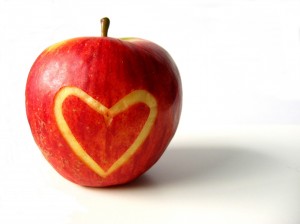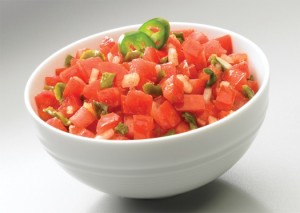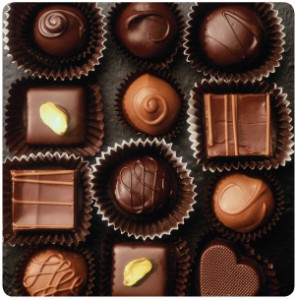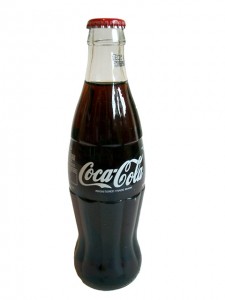The 21 day exercise and meal plan program includes the 72 hour contest prep diet also known as the 3 day Quick Fix. The details are included in the kit.




September 8, 2015
March 23, 2012
Low-Fat Beats Low-Carb For Heart Health
For people at risk for hypertension, reducing fat intake may be key to protecting the heart. According to a study published in the American Heart Association’s journal Hypertension, a low-fat diet is more effective than a low-carbohydrate diet in reducing the risk of developing hypertension, a precursor to cardiovascular problems such as atherosclerosis.
When the two types of diets were compared in apparently healthy participants, the low-fat diet was the winner at improving blood pressure markers, such as blood flow in the arteries. This led the researchers to conclude that low-fat diets “may confer greater cardiovascular protection” than low-carb diets.
—
source: IDEA Fitness
March 22, 2012
Hot Salsa Tip
Did you know that salsa has surpassed ketchup as America’s favorite condiment? Salsa can spice up all kinds of bland meals. Stir in a jar of your favorite salsa to add some zing to a pot of kidney, white, pinto, red or black beans; then top with a dollop of sour cream for a unique, high-fiber side dish.
March 21, 2012
How to Stop Yourself Eating from Boredom
 People who struggle with their weight are often prone to “emotional eating”, consuming food as a response to mental triggers rather than physical hunger. Often, dieters fail to lose weight not because their diet plan itself is flawed, but because they are knocked off course by feeling stressed, tired, upset or bored.
People who struggle with their weight are often prone to “emotional eating”, consuming food as a response to mental triggers rather than physical hunger. Often, dieters fail to lose weight not because their diet plan itself is flawed, but because they are knocked off course by feeling stressed, tired, upset or bored.
The last of these is an especially common cue for many people to eat. For some, it’s a habit learned in childhood (“I’m bored, mum!” – “Run down to the shop and buy yourself a candy bar, then.”) For others, it’s a reaction to the dull parts of adult life: munching on biscuits while rocking the baby to sleep, or getting yet another handful of chocolates because the afternoon is really dragging at work.
Avoid Snacking When You’re Bored
When you find yourself thinking, “I’m bored, maybe I’ll have a cookie,” then get straight out of that mindset:
- If you’re genuinely hungry, have some fruit or a small sandwich.
- Cravings can be beaten, just by sitting them out. Force yourself to wait 20 minutes before getting that snack, and nine times out of ten, you’ll no longer want it.
- Find something to do – ideally, an activity that makes it hard to eat at the same time.
Understanding Your Danger Points
Keep a food diary for a couple of weeks, and write down not only what you ate and when, but why you ate. (Hunger, because friends were eating, because it was lunch-time, boredom, stress..?)
When are you most likely to eat from boredom? Maybe it’s when you have to hang around at home, waiting for a delivery. Or perhaps it’s when you get in from work and you’re waiting for your partner to come home. Once you’ve figured out the pattern, work out how to change it!
- Find a hobby or interest to occupy you, if you’ve got too much time on your hands
- Use those “hanging around” moments, to blitz through all the little jobs you keep putting off (cleaning the oven, anyone?)
- If you’re regularly twiddling your thumbs at work, see if there’s a stressed colleague who could use your help.
What are your tips for avoiding boredom-induced snacking?
—
Article courtesy of: diet-blog
Image courtesy from: Tony Jalicea
March 19, 2012
6 Fitness Tips to Follow While Traveling
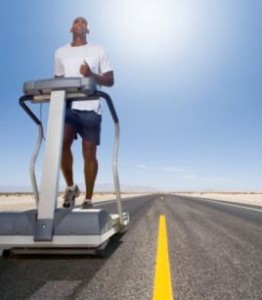 If on the whole you make the effort to eat healthy and have an effective exercise regime, you are likely to be concerned that any travel plans will derail this process. So here are some tips that will help you continue with your fitness programs even when you travel.
If on the whole you make the effort to eat healthy and have an effective exercise regime, you are likely to be concerned that any travel plans will derail this process. So here are some tips that will help you continue with your fitness programs even when you travel.
1. Do some homework before you leave. Check if the hotel that you plan to stay in has gym facilities or a pool and so on (depending upon your preferred workout activity).
2. Remember to pack workout clothes and shoes. This will remind you to work out and also make it convenient to hit the gym or simply head out for a walk wherever you are staying.
Workout shoes can be bulky so rather than carrying them in your baggage, you can simply wear them when you travel and instead pack the other less bulky shoes into your bag.
3. Carry a jump rope or a couple of dumbbells or kettle bells with you. A session with the jump rope can be a really strenuous workout in a short time, and doing a few weights with dumbbells or even lifting some bottles of bottled water can be a good workout.
4. Do other exercises that don’t need equipment – pushups, leg raises, squats, lunges and stair climbing are all easy to do wherever you are.
5. When eating out, order items that are steamed, grilled or poached. Avoid the items that are fried or calorie rich – if it says ‘crispy’ or ‘golden’, it’s probably been deep-fried, if it says ‘rich gravy or dressing’ that means high in calories too.
Also remember if it is a salad you’re ordering, ask for vinaigrette dressing rather than a cream or mayo-based one. Order small portions and opt for fruit instead of a confection at the end of the meal
—
Courtesy from FitnessHealthZone
March 17, 2012
Ready to Rock Your Body for the Summer Heat?
April 15, 2011
7 Breakfast Foods to Swap In, Not Out
Is breakfast really the “most important” meal of the day? Maybe, at least that’s what they told us in health class.
So if breakfast is the first meal of the day and you’re trying to lose weight, it’s probably a smart idea to make your first meal a good one.
And since most dieters judge food by two simple factors: fat and calories. Here are seven foods you should ditch and seven foods you should switch to if you’re looking for a better breakfast.
English Muffin or Bagel?

Sorry, but a bagel with a schmear of cream cheese just isn’t Kosher – at least not for dieting. You’re better off switching to toasted nooks and crannies dripping with melted butter.
*English Muffin, with butter
5.8g total fat
189 calories
Bagel, with cream cheese
8g total fat
436 calories
Apple or Banana?

Let’s face it, both apples and bananas are awesome – probably the healthiest foods on this list – but, if you’re looking to cut calories, go with the apple.
*Apple
0.17g total fat
50 calories
Banana
0.33g total fat
100 calories
Blueberry Yogurt or Oatmeal?

Even without the “probiotics,” eating a light yogurt is smarter than a bowl of old fashioned oatmeal.
*Dannon Light’n Fit Blueberry Yogurt (6oz)
0g total fat
80 calories
Old Fashioned Quaker Oats, with water (1/2 cup)
3g total fat
150 calories
Coffee with Skim Milk or 2% Milk?

For most people, missing their morning coffee is grounds for murder. So please, drink up! But make sure you stick with non-fat milk, not 2%
*Starbucks Coffee, with non-fat milk (short)
0g total fat
35 calories
Starbucks Coffee, with 2% milk (short)
2g total fat
50 calories
Wheaties or Raisin Bran?

One cereal uses professional athletes to push product. Another is peddled by the sun. The sports stars win, go with a bowl of Wheaties.
*Wheaties (1 cup)
1g total fat
110 calories
Raisin Bran (1 cup)
1.3g total fat
190 calories
Turkey Bacon or Pork?

It isn’t real bacon – it might not even taste like it – but the fat and calories don’t lie. Spare a pig, eat a turkey!
*Butterball Bacon-Style Turkey (1 slice, 18g)
3g total fat
40 calories
Pork Bacon (3 slices, 19g)
7.9g total fat
103 calories
Grapefruit Juice or Orange Juice?

Grapefruit juice might not taste as sweet, but choke it down. It’s better than orange juice. And when you drink grapefruit juice, it’s less likely to squirt in your eye.
*Tropicana Grapefruit Juice (8 fl oz)
0g total fat
90 calories
Tropicana Orange Juice (8 fl oz)
0g total fat
110 calories
April 8, 2011
“Vegetarian” Diets Reduce Heart Risks
 Eating a meat-free diet may lower your risk of developing heart disease, suggests a new study, helping to lessen the likelihood of metabolic syndrome.
Eating a meat-free diet may lower your risk of developing heart disease, suggests a new study, helping to lessen the likelihood of metabolic syndrome.
Metabolic syndrome is a collection of diseases that contribute to cardiovascular disease, including diabetes, obesity, and high blood pressure.
Researches found vegetarians had better blood sugar, blood fat, blood pressure, waist size, and body mass measurements than non-vegetarians.
In the study, 23 out of every 100 vegetarians were found to have at least three metabolic syndrome factors, compared with 39 out of every 100 non-vegetarians and 37 out of every 100 semi-vegetarians.
For the study, published in the journal Diabetes Care, scientists analyzed the diet of three different groups of people: vegetarians, non-vegetarians, and semi-vegetarians; in total, more than 700 adults.
The researchers used a questionnaire to obtain information on participants’ eating habits. People were classified as vegetarian, eating meat less than once a month; semi-vegetarian, eating meat less than once a week; and non-vegetarians. However, the term “vegetarian” is incorrectly defined; true vegetarians never eat meat.
Results showed vegetarians had an average body mass index (BMI) of 25.7. Unlike non-vegetarians who had an average BMI close to 30. Semi-vegetarians’ BMI fell between the vegetarians and non-vegetarians.
A BMI between 25 and 29 is considered overweight and a BMI from 30 and up is obese. Normal weight is between 18.5 and 25.
The findings remained steady when researchers combined all the readings to determine the risk of metabolic syndrome.
In 2008, Vegetarian Times reported that 7.3 million Americans follow a vegetarian diet: 59% are female, 41% are male. As of 2009, the total U.S. population was nearly 308 million.
According to the American Heart Association, a vegetarian diet – with its heavy vegetable consumption and low intake of saturated fat from animal products – has been shown to reduce the risk of heart disease, heart attack, obesity, high blood pressure, and some forms of cancer.
Article courtesy from diet-blog
Image courtesy from first reason blog
January 31, 2011
Chocolate
Valentine’s Day is just weeks away, which means only one thing to many lovers: Time to bust out the chocolate! With all the recent media hype about the health benefits of this sweet concoction, many chocoholics are rejoicing. But can that solid chocolate heart from your sweetheart really be good for your ticker?
Health Benefits. Chocolate is made from cacao beans, which contain flavonoids,the same kind of beneficial plant compounds found in fruits, veggies, red wine and green tea. Research suggests that these flavonoids may have a positive effect on the cardiovascular system and may reduce the risk of heart disease and certain cancers. Other studies have linked chocolate consumption to reduced blood pressure, enhanced blood vessel function and improved cholesterol levels.
Cautionary Caveats. It should be noted that these protective health effects have been seen primarily with dark (not milk) chocolate, as dark varieties tend to have a higher proportion of flavonoids. The way chocolate is processed can also affect how much flavonoid content is retained. Finally, it is essential to remember that all chocolate contains high levels of fat and calories. The fat in chocolate can account for 50%–75% of its total calories, most of that being saturated fat from cocoa butter.
Comparing Varieties. Unsweetened cocoa contains 66 calories with 3.9 g of fat; baking chocolate weighs in at 142 calories with 14.1 g of fat; sweet dark chocolate has 143 calories with 9.7 g fat; semisweet chocolate yields 136 calories with 8.5 g of fat; milk chocolate packs 152 calories with 8.4 g of fat; and white chocolate yields a whopping 162 calories with 9.1 g of fat!
Choosing Wisely. Although some manufacturers have begun to list the candy’s cocoa content, even dark-chocolate lovers are mostly in the dark when it comes to picking the brands with high flavonoid levels. That’s why experts warn that chocolate should be consumed in moderation, as part of a healthy, varied diet. Eating any food in excess of caloric needs will result in weight gain.
January 19, 2011
Can That Cola To Strengthen Bones
Soft drinks are high in calories and low in nutritional value. While that doesn’t stop most of us from hoisting a soda occasionally, maybe a report in the October 2006 issue of the American Journal of Clinical Nutrition will give cola drinkers pause.
